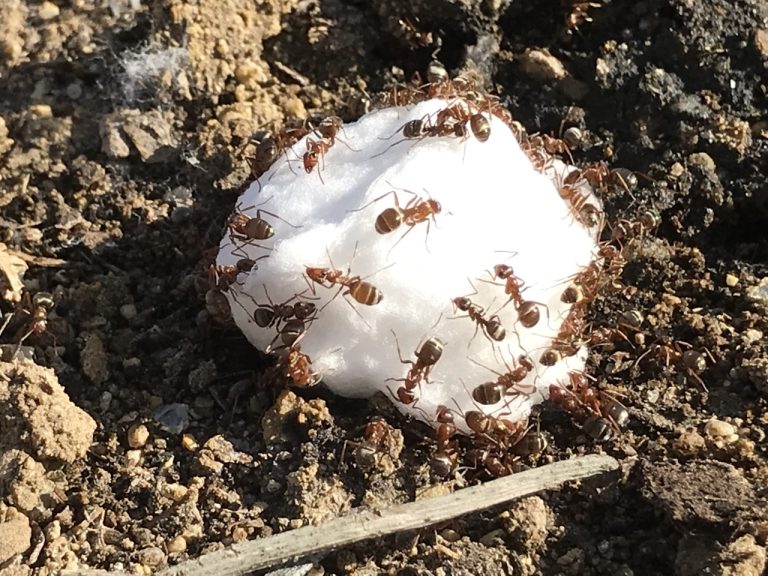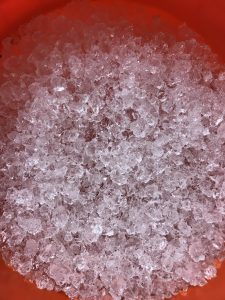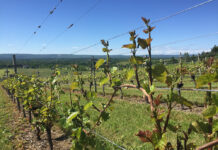
Sugar-feeding ants are the monkey wrench in a vine mealybug (VMB) integrated pest management program.
Not only does their feeding on honeydew secreted by VMB promote sooty mold on grape clusters, ants know their next meal depends on VMB and actively protect this invasive pest from predator insects and parasitoids that provide biological control and are part of a vineyard integrated pest management program.
Vine mealybugs feed by sucking plant juices. They excrete honeydew which attracts sugar-feeding ants. Since the introduction and spread of VMB in California vineyards, the presence of sugar feeding ants in vineyards has become a much larger issue. Chemical and biological IPM strategies can work in controlling vine mealybug, but when sugar-feeding ants are present, biological control efficacy is impacted.
David Haviland, UCCE entomologist in Kern County, said sugar-feeding ants interrupt VMB control measures, protecting this invasive grapevine pest by killing or intimidating VMB predators and parasitoids that exist in the vineyard. Chemical controls for VMB are a challenge as this mealybug species has numerous life stages that can be present at the same time. Adults or nymphs or eggs may be killed, but unaffected stages re-populate grapevines. Ants can also help VMB survive by moving them under bark to escape contact insecticides.

Presence of sugar-feeding ants in a vineyard minimizes impact of an integrated pest management plan, Haviland confirmed.
There are different species of ants that cause the same problem for VMB control throughout all grape growing regions of California.
The sugar-feeding invasive Argentine ant is the most prevalent ant species in coastal vineyards. It is about 3 millimeters in length, is uniformly deep brown to black and does not bite or sting. It has one hump between the thorax and abdomen. Worker ants forage during the day. Their populations peak in mid-summer and early fall. Ants nest usually within 2 inches of the soil surface.
In the San Joaquin and Coachella valleys, sugar-feeding native gray ants are most prevalent. These ants are 7.5 millimeters in length and, like the Argentine ant, have one hump. Gray ants nest in the topsoil or under rocks or vineyard debris. They move in an irregular, jerky motion and generally do not travel along trails or sting. Different sub species are found in the San Joaquin and Coachella Valley. The thief ant is the smallest sugar-feeding species and is found primarily in the Coachella Valley.
Other ant species may be found in vineyards, but they are primarily protein feeders.
Control Has Become Harder
Haviland said control of ants in vineyards has become problematic due to loss of the effective chlorpyrifos and increased demand by markets for use of sustainable farming practices. Integrated pest management fills that need, but without ant control is less effective.
Prior to the loss of the organophosphate insecticide Lorsban, it could be used to knock back ant populations in vineyards, Haviland said. An added emphasis on biological control methods in grape production has led growers to encourage native predator populations or to purchase parasitoids to distribute in vineyards.

To preserve the viability of these biological controls, a search began for innovative ant control measures.
Haviland, who spoke about innovations in ant control at the Southern San Joaquin Valley Grape Symposium, said the granular ant baits are more attractive to protein feeding ant species and fail to cut into sugar-feeding ant populations.
Varying environmental conditions in all California grape growing regions also pose difficulty for ant control measures. Liquid baits placed in bait stations are used in vineyards but have not been widely adopted, Haviland said, due to costs. The number of stations needed to be effective and the labor required to maintain them are challenges. High summer temperatures also cause the water portion of the bait to evaporate, and the concentrated bait left is no longer attractive to ants, compared to their diet of VMB honeydew.
Hydrogel Bait as a New Solution
In exploring other options for ant bait delivery, Haviland turned to hydrogels.
There is no shortage of hydrogel definitions in scientific publications, but the easiest to understand is that a hydrogel is mostly a mixture of porous, permeable solids at least 10% by weight or volume of interstitial fluid composed completely or mainly by water. Hydrogels have three-dimensional network structures which can absorb relatively large amounts of fluid (think diapers).
Haviland said sucrose absorbed by hydrogels makes “artificial honeydew.” Very small amounts of pesticide are added to the mix for ant control.
“The amount needed is 100 times lower than is used on foliage for pest control,” Haviland said. The concentration of pesticide is one-tenth of normal use of product. Trials have done applications at rates of 10 gallons of hydrogels per acre, and in some trials, it was effective at 5 gallons per acre.
There are a lot of different types of hydrogels, and Haviland said UC Riverside Entomologist Mark Hoddle’s research found polyacrylamide gels, which have a high level of degradability, are suited for carrying a pesticide mixture.
After hydrogels absorb the sucrose and pesticide mixture, they can be broadcast across a vineyard floor with a broadcast spreader. Haviland explained ants are attracted to this sugar source with a ‘Jello’ consistency that is wet on the outside.
This bait delivery system is experimental, Haviland stressed, but is showing promise in field trials. There is also an example of use of hydrogels to successfully eradicate Argentine ants. At Channel Islands National Park, Argentine ants were threatening populations of native birds. Hydrogel baits were used, and over time, ants were eradicated from Channel Islands.
Haviland said this technology is currently not registered for use as hydrogel delivery is not on any insecticide label. The process to supplement current insecticide labels for use in hydrogel delivery has started, he said. This would involve a 24-C petition to use a pesticide in a different manner than what is noted on the label.
When this ant bait delivery system is approved, Haviland said the window to apply in San Joaquin Valley vineyards would be March 15 to May 1. Honeydew isn’t being produced in large quantities before May, he said. The expected program would be two applications of hydrogels a month apart in valley locations. Timing would be adjusted for coastal or desert areas.






